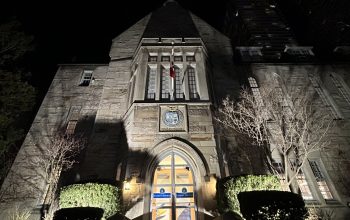A look at the controversial Mandatory Leave of Absence policy
Emily Barber NEWS EDITOR
Photo: The University of Toronto’s Governing Council Boardroom. U of T.
Fall 2018 marks the beginning of a full school year under the University of Toronto’s (U of T) new mandatory leave of absence policy. As such, it is necessary to explore what this policy is, and the controversial 18-month journey it took to become a reality.
What is the policy?
On June 27, 2018, the revised policy was approved by U of T’s Governing Council and was implemented immediately. This latest version of the mandatory leave of absence policy is intended as a last-resort measure for students who — due to extreme cases of mental illness — are at risk of harming themselves and/or others, or whose studies are being negatively impacted by mental illness.
“The policy states that a regulated health professional will be consulted as part of the consideration of a mandated leave of absence,” writes U of T Media Relations Interim Director Elizabeth Church. “[The policy] is to be applied in rare cases, only after accommodative measures have been unsuccessful, or the student has declined those measures.” These measures include an option for students to take a voluntary leave of absence.
Church further elaborated on the intent of the policy. “It is designed to give the University a way to respond that is not punitive to concerning behaviour that is believed to be a result of serious mental health or other issues,” she maintains. “The policy emphasizes that the mandated leave of absence is not to be punitive.”
Use of the policy is at the discretion of the University-appointed administrator known as the Vice-Provost. The decision to put a student on mandatory leave is in consultation with the head of the student’s faculty, an appointed Student Case Manager, a regulated mental health professional, and a Student Support Team. This Support Team can include student service representatives, registrational personnel, additional medical professionals, academic administrators, equity officers, campus safety personnel, and Campus Police.
In urgent cases such as those involving serious threats or violent behaviour, the Vice-Provost can immediately remove the student from the university without going through the normal process of securing a mandated leave of absence. Such an action can be effective for up to five business days.
According to the official version of the policy published by the Governing Council, “the goal of the University is that the student can resume academic activities safely and with a reasonable prospect of engaging in the basic activities required to pursue an education at the University.”
The Controversy Explained
There has been much debate surrounding the installation of this policy and its potential consequences. The policy took 18 months of revisions and consultations, and concerns are still being raised about how it will affect students.
On January 29, 2018, the Ontario Human Rights Commission (OHRC) strongly recommended that the policy not be allowed to go through in the form it was in at the time. A letter from Chief Commissioner Renu Mandhane was sent to the Chair of the Governing Council pointing to numerous issues and potential human rights concerns that arose from the policy at the time.
Among those concerns was, under the old policy, decisions were made by university administrators with no special training in human rights or risk assessment instead of experts specifically trained in human rights, risk assessment, or mental illness.
“The risk assessment must be based on objective evidence (such as a medical assessment) and cannot be based on subjective views (that may be informed by stereotype),” Mandhane writes. “Ultimately, the decision to exclude a student from school due to alleged health and safety risk without sufficient objective evidence, and without meeting the undue hardship standard set out in the Code, may constitute discrimination.”
Another key concern highlighted by Mandhane was the lack of assistance the policy had for students that pose a threat to themselves or others. “The policy appears to allow the University to immediately put the student on leave and withdraw essential services (housing, health, and counselling services) at a time when the student is in crisis and most in need of support,” he writes. “This approach is not consistent with the policy’s intent of preventing harm.”
One day after the OHRC letter was sent, recommendation of the policy was withdrawn from the agenda of the University Affairs Board according to the policy timeline released by the Governing Council.
Student concerns and comments
The Scarborough Campus Students’ Union (SCSU) were among those that raised issues with the draft of the policy that has been approved. On May 15, 2018, a letter to the Vice-Provost Students Office detailed a number of problems SCSU still saw in the policy despite its OHRC-recommended revisions. Notably, SCSU saw the current version as still limiting the role of medical professionals.
“The proposed policy allows for these important assessments and decisions to be made by the administration who do not have the necessary training,” SCSU writes. “As outlined by the OHRC, this is problematic because it discredits the importance of medical expertise in a policy rooted in perceived good health.”
Another issue SCSU identified was the effect on students outside of education. “There is no guarantee of a students’ access to resources including, but not limited to, campus healthcare services, emergency housing, and work-study positions,” SCSU writes. “Access to healthcare, housing, and employment are key social determinants of health which can be jeopardized by the implementation and invocation of this policy.”
An online student consultation platform that ran from April 26 to May 16, 2018 revealed mixed views on the policy. According to a feedback report from the Governing Council, a number of students “feel strongly that such a policy is not necessary and rather greater resources should be put into campus support services.” Comments were also received regarding a “perceived lack of consultation and the limited time to provide comments in the latest round.”
The revised version was re-introduced to the University Affairs Board on May 24, 2018, for recommendation.
When the revised policy was approved by the Governing Council on June 27, 2018, The Varsity reported that the signing of the policy prompted demonstrations by students from all three U of T campuses, Ryerson University, and York University. Nour Alideeb, Chairperson of the Canadian Federation of Student–Ontario (CFS–Ontario), was also in attendance.
In the same article, The Varsity references U of T’s 2018–19 operating budget. “The $1.5 million allocations [for mental health services] make up approximately 0.06 percent of the university’s $2.68 billion budget.”
Another article from The Varsity published September 10, 2018, recounts one student’s mental health struggles, the misgivings they have about the effectiveness of the policy, and the potential for abuse of power on the university’s part.
One particular concern this student had was the policy’s stipulation that in order to get off mandatory leave, a student has to apply 30 days before the start of the semester. Failure to do so may result in the university terminating the student’s registration. The student pointed out that in their case, 30 days before the start of the semester would have been too far in advance to determine their readiness, and, had the policy been in place at the time, could have jeopardized their degree.
Looking forward
University spokesman Liz Church addressed the use of the policy in 2018.
“Because the policy went into effect recently, we don’t have statistics to share,” she says. “But out of more than 90,000 students at U of T, we expect the policy to be used a few times a year.”
Church maintains that the installation of the policy has not stopped the conversation about its use. “We are going to continue to meet with student leaders, to talk about the policy, to work together on this issue, and to make sure we do everything we can to support students who are going through serious health, mental health, or personal issues.”
The current version of the policy does address the flaws pointed out by the Ontario Human Rights Commission, and attempts to meet the concerns brought up by students. Use of the policy this year will determine whether these revisions will be sufficient in meeting student needs as well as avoiding discrimination and human rights violations.




